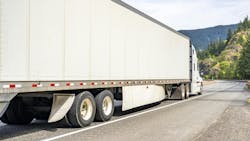Key takeaways:
- Trailer aerodynamics devices can improve fuel efficiency by 1% to 10%.
- The gap between the trailer and tractor, the underbody, and the rear of the trailer are three areas ripe for drag reductions.
- A fleet's unique duty cycle will determine which aerodynamic solutions fit best.
For many fleets, if not most, it’s not possible to pair a specific tractor with a specific trailer on a regular basis. Yet to achieve peak efficiency, it’s best to reduce the overall aerodynamic drag of the combination vehicle.
Over the years, fleets have invested significantly in improving the aerodynamics of the tractors they operate. Yet in many cases, little is done to make trailers sleeker. The reality is that trailer aerodynamic devices help increase fuel efficiency by reducing air resistance, allowing the vehicle to travel further on less fuel.
When it comes to trailer aerodynamics, fleets can achieve fuel economy improvements in the 1% to 10% range, depending on the device(s) they choose. Fortunately, or unfortunately, depending on your point of view, there are a number of trailer aerodynamic technologies available. This can make choosing the right one for your application more difficult.
See also: How Cummins is tackling alternative fuels
There are three areas of the trailer where aerodynamic drag can be reduced: the gap between the tractor and the trailer, the underbody, and the rear.
For the underbody, trailer skirts are the most popular devices for addressing drag. All trailer underbody skirts extend the trailer sidewalls much closer to the ground, preventing wind from ducking in under the trailer and running into the non-aerodynamic trailer bogie. Trailer skirts offer 1% to more than 5% more fuel savings than trailers running without skirts.
Devices mounted at the rear of trailers modify the airflow as it leaves the trailing edge of the side and top surfaces of the trailer. The goal of all trailer rear devices is to reduce the wake field following the trailer, which can affect the air some distance behind the trailer.
Tractor-to-trailer gap management devices are relevant for a subset of the industry, in large part because of the evolution of the current aerodynamics of many tractors. Highly aerodynamic tractors have largely reduced the importance of trailer aerodynamic gap devices. However, many older tractors and day cabs that require a higher tractor-to-trailer gap for maneuverability would still benefit from trailer devices that address drag in the gap. Even the newest models can benefit from active devices that completely close off the gap at highway speeds.
In our Confidence Report on trailer aerodynamics, we offered the following specific recommendations for selecting the appropriate trailer aerodynamic device:
- If you are operating an aerodynamic tractor with a dry van trailer, consider adding trailer skirts.
- If your trailer already has side skirts, consider adding a trailer rear device.
- If your trailer already has side skirts and a trailer rear device that needs to be deployed manually, consider upgrading to the next generation of self-deploying rear devices.
- If your trailer has side skirts and a rear trailer tailer, consider adding a trailer front nose fairing and/or automatic gap closure device.
- If your trailer has side skirts, rear tail device, and nose cone fairing, begin looking into minor areas such as wheel covers, vented mud flaps, and even the position of the license plate.
- If you are operating a day cab tractor with a large tractor-trailer gap, consider adding a trailer-mounted gap device.
It is important to remember that no technology is perfect and there are challenges associated with adding trailer aerodynamic devices. Those include the fact that these devices add weight, there may be concerns about their reliability and durability, and the devices may require some maintenance or repair should they get damaged. The good news is that device manufacturers are working to reduce the weight of these devices at the same time they are trying to make them more durable.
Challenges aside, NACFE is highly confident that all fleets should be looking at the aerodynamic efficiency of their trailers and consider adopting devices that will improve the trailer’s aerodynamics, since they present a major opportunity to save fuel. The best device or package of devices to adopt will depend on a fleet’s unique duty cycle. Overall, however, available savings are quite high, up to 10%, for the majority of fleets running 53-ft. dry box trailers. And that can have a significant impact on the bottom line.
About the Author

Michael Roeth
Executive Director
Michael Roeth is the executive director of the North American Council for Freight Efficiency. He serves on the second National Academy of Sciences Committee on Technologies and Approaches for Reducing the Fuel Consumption of Medium and Heavy-Duty Vehicles and has held various positions with Navistar and Behr/Cummins.
